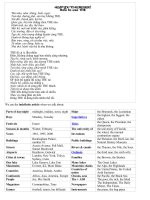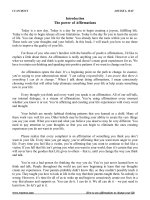How to Use Accounting as Strategy
Bạn đang xem bản rút gọn của tài liệu. Xem và tải ngay bản đầy đủ của tài liệu tại đây (110 KB, 3 trang )
inc.com
/>How to Use Accounting as Strategy
Accounting isn't just a necessary evil; sometimes the methods used can be a key part of your
business strategy.
shutterstock images
Dear Jeff,
I'm starting a business and I know very little accounting. Does it make a difference which type of
inventory accounting method I use? Or does it all work out the same?
Name withheld by request
A lot depends on the nature of your business. In some cases accounting methods can actually be
part of your business strategy; inventory accounting is one of those methods.
Background first. There are four basic inventory accounting methods:
Specific identification
Weighted average
First-in, first-out (FIFO)
Last-in, first-out (LIFO)
Specific identification carries items on your books at their actual cost. Specific identification is
typically used for major (meaning expensive) commodities like cars, jewelry, or sophisticated
equipment. That's fine if you have 20 Rolexes in your display case but it's not so convenient if
you carry hundreds or thousands of products.
Weighted average is typically used when products are physically indistinguishable or easily
substituted, like commodities. Under the weighted average method every unit in inventory is priced
using an average of the cost of all items in inventory. Say you buy 20 barrels of oil at $100, 20
barrels at $110, and 20 barrels at $120; your average cost is $110. Under the weighted average
method when you sell a barrel of oil you assume your cost was $110, regardless of what you
actually paid for that individual barrel.
Since most businesses don't mostly carry expensive items or commodities, most businesses use
LIFO or FIFO inventory accounting.
Under FIFO the assumption is that the oldest inventory is used first. (In many businesses that is in
fact what happens, regardless of the accounting method.) As a result, the ending inventory is
valued on your balance sheet at a cost closest to the current cost since prices tend increase over
time. The cost of goods sold is based on a lower cost since older and therefore cheaper items are
assumed to be the items sold.
Under LIFO the assumption is that the last items purchased are the items sold, meaning the more
expensive items were used. The cost of goods sold is therefore relatively higher and the value of
goods remaining on the balance sheet is lower since those are older items purchased at a lower
price. (Again, assuming that prices have increased over time.) Under LIFO your profits are lower
compared to FIFO accounting.
So where does business strategy come into play? If you feel your inventory costs are likely to
remain stable or increase, the LIFO approach probably makes sense. Companies that use LIFO
inventory valuations are typically those with relatively large inventories and increasing costs
because LIFO typically results in lower profit levels, lower taxes, and as a result higher cash flow.
Think of LIFO accounting as providing a deferred tax advantage. On the flip side, LIFO also results
in a weaker balance sheet since the value of your inventory is lower.
FIFO inventory accounting provides more accurate inventory valuations since the assumption is
the items remaining in inventory were purchased at more recent and typically higher prices. Under
FIFO the value of inventory is higher compared to LIFO.
So let's break it down.
If you sell products as a retailer or a manufacturer and the cost of your supplies or products
tends to increase over time (and what doesn't cost more over time?) using LIFO will typically result
in lower taxable income compared to the FIFO.
But keep in mind that if you need to maintain a relatively strong balance sheet to qualify for
loans, to satisfy investors, or to impress analysts FIFO may be the way to go.
So with all that said: Talk to your accountant. Explain the nature of your business and your short-
and long-term goals.
Then pick one and move on to another "accounting strategy" that's a lot more important:
Generating revenue and making profits.
Jeff Haden learned much of what he knows about business and technology as he
worked his way up in the manufacturing industry. Everything else he picks up from
ghostwriting books for some of the smartest leaders he knows in
business. @jeff_haden









